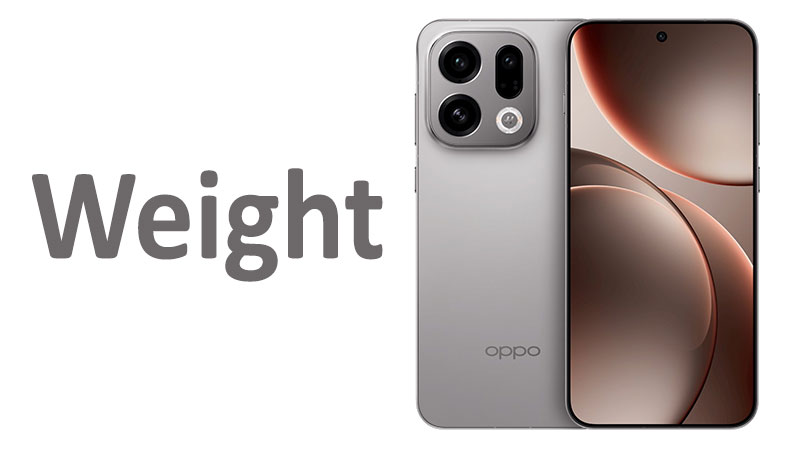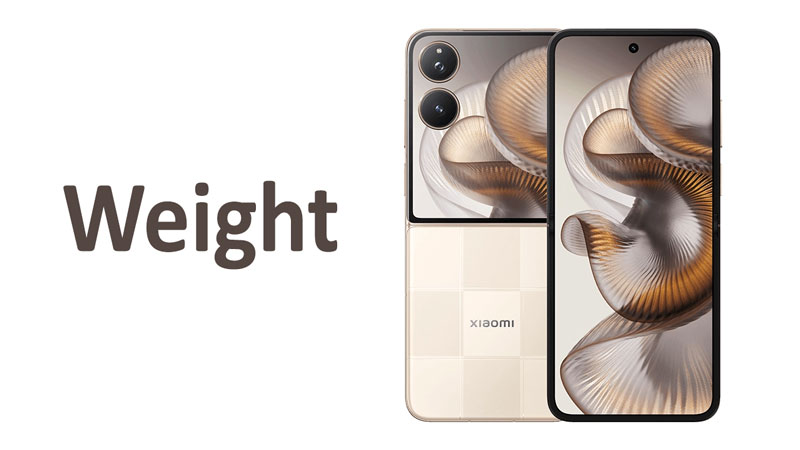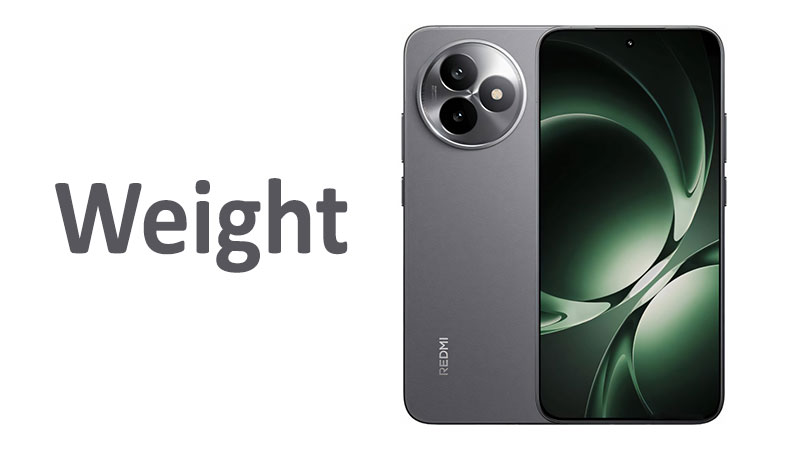The Oppo Find X9 weight is a critical factor influencing its premium market appeal. Device mass affects how users experience the phone daily. It dictates comfort during long sessions. It also impacts overall pocketability and portability. Understanding the exact figure is vital for consumers. This detailed analysis will thoroughly detail the Oppo Find X9’s weight specification. We will investigate the implications of its balanced mass. Furthermore, we will compare this figure against key competitors. This comprehensive review reveals why the phone’s mass is a calculated design choice.
Core Weight Specification: 203 Grams (7.16 Ounces)
The Oppo Find X9 weighs exactly 203 grams (g). This mass translates to 7.16 ounces (oz) in the imperial system. This figure is significant in the premium smartphone category. It places the device squarely in the modern flagship range. Most high-end phones aim for this approximately 200-gram range. This weight suggests a design focused on powerful features without excessive bulk. The 203 g specification confirms a commitment to hardware complexity.
The weight reflects a balanced trade-off. This balance prioritizes robust features and material quality. The Oppo Find X9 weight is highly strategic. It is heavy enough to feel premium and durable. However, it is light enough to avoid being cumbersome. This mass is a strong indicator of component choice. It suggests a high-capacity battery is present. Complex, multi-lens camera systems also contribute to this mass. These factors explain the slightly higher than average weight. Therefore, the 203 g figure is a sign of uncompromising flagship specifications. Buyers expect a solid, feature-rich device at this weight.
The Significance of the Gram Measurement
A mass of 203 grams is frequently associated with robust construction. It indicates the use of dense, high-quality materials. These materials include metal frames and protective glass panels. The mass also suggests a large internal battery is included. This battery provides necessary power for the phone’s high-end features. Consumers often perceive this mass as superior build quality. A heavier phone generally feels more solid and less prone to flexing. This tactile experience reinforces the premium status effectively. The 203 g mass is intentional and functional.
The Ounce Equivalent: 7.16 Ounces
The imperial measure of 7.16 ounces provides an essential comparison for many users. This weight is similar to a standard softball or a moderate coffee mug. It quickly establishes the phone as substantial in mass. It is not an ultra-light device by any definition. This significant ounce measurement reinforces the need for secure handling. Users should plan on utilizing two hands for prolonged interactions. This mass aligns perfectly with the device’s feature set. The weight is a functional consequence of the phone’s powerful design.
The Ergonomic Profile of 203g
The 203 g mass significantly shapes the phone’s ergonomic profile. This mass provides a satisfying, high-quality feel in the hand. Many users associate this density with excellent build quality. The phone feels secure and less fragile when held. This tactile feedback reinforces the device’s premium nature. The weight is distributed carefully across the phone’s frame. Good weight distribution minimizes uneven pressure on the hand.
Handling and Long-Term Comfort
Handling the phone for short periods is comfortable. However, extended use demands attention to wrist fatigue. Holding the device for long gaming sessions requires stability. Consumers may need to rest their hands frequently. The 203 g mass is manageable for daily tasks. It avoids the strain associated with ultra-heavy models. This weight strikes a decent middle ground for most users. It balances the need for robust internals with user comfort. This ergonomic balance is critical for long-term satisfaction.
One-Handed Usability Assessment
The 203 g mass supports one-handed use better than heavier rivals. While still substantial, it avoids the extreme mass of Pro models. Users can often manage quick interactions with one hand. They must still exercise caution against accidental drops, naturally. The weight is heavy enough to generate high inertia if dropped. Therefore, a secure grip is absolutely essential at all times. This mass is an integral part of the phone’s daily user interaction. It requires deliberate handling.
Pocketability and Daily Portability
Pocketability is another key consideration for this device mass. The 203 g mass is noticeable in lighter clothing. It can cause pockets to sag slightly. Users should use secure pockets when carrying the phone. The phone’s physical size compounds the effect of the mass. A large-screen device already occupies substantial space. The 203 g weight adds to that perceived bulk. Despite this, the phone remains highly portable. It is not heavy enough to be truly cumbersome. It is an acceptable trade-off for a flagship device.
The phone is easily carried in bags and jackets. It does not add excessive drag or discomfort. However, users should be mindful of the mass during travel. The Oppo Find X9 weight is a constant presence. It remains a comfortable, daily companion for most users. This balanced mass makes it highly versatile.
Design Philosophy and Engineering Trade-offs
The 203 g mass results from deliberate engineering and internal component selection. Oppo made specific choices to maximize performance and endurance. These technical decisions collectively determine the final device mass. Understanding these choices explains why the phone is not lighter.
Battery Technology: The Primary Mass Driver
The battery unit is the primary driver of the grams specification. A mass of 203 g strongly suggests a high-capacity battery is present. This battery likely exceeds the standard 4,500 mAh capacity. A capacity closer to 5,000 mAh is more probable. This large power cell provides excellent, all-day endurance. Choosing a large battery requires accepting the corresponding mass increase. This trade-off prioritizes battery life over ultra-light design. Oppo understands many users value long usage times highly.
This battery choice ensures reliability. Users can depend on the Find X9 throughout the day. They do not need to carry a portable charger constantly. The weight is directly linked to this freedom from constant charging. This commitment to power is a key flagship feature. The 203 g mass is therefore a positive indicator of longevity.
Advanced Camera Systems and Optics
The sophisticated camera module also adds significant mass. Flagship phones like the Find X9 feature complex optics. They include multiple lenses and large sensors. Optical image stabilization (OIS) mechanisms also require small motors. These components are inherently denser than other internal parts. High-quality zoom lenses, for example, increase the Oppo Find X9 weight substantially. The 203 g figure confirms the inclusion of these advanced imaging systems.
Camera modules continue to grow in complexity and size. They add mass to the top of the phone’s structure. Good engineering distributes this mass effectively. This prevents the phone from feeling overly top-heavy during use. The device mass is a necessary result of these advanced components. Buyers acquire superior photo and video quality at this weight.
Material Choice and Structural Integrity
Material selection is another key factor contributing to the mass. Oppo likely uses a robust aluminum alloy frame. The phone probably features durable glass back panels. These materials ensure structural rigidity and a premium feel. They inherently weigh more than plastic or composite materials. The use of high-strength glass adds density. This material strategy ensures long-term durability. It protects the costly internal components effectively. Therefore, the 203 g mass is a marker of premium, robust construction.
The density of the materials also contributes to thermal performance. Metal frames help to dissipate heat efficiently. This prevents the phone from becoming too hot during heavy load. The durability gained from these materials justifies the mass. This is a common and necessary trade-off in the premium segment.
Cooling Systems and Performance
The internal cooling system also adds to the total mass. High-performance chipsets require effective thermal management. The phone likely utilizes a large vapor chamber cooling system. This system contains liquid and metal components. These elements are necessary to sustain peak processing speeds. They prevent the phone from overheating during demanding tasks. The mass associated with these cooling elements is unavoidable. It is a vital contribution to the 203 g total. This commitment to cooling ensures stable, fast performance. The weight supports consistent processing power over time.
Specialized Comparisons and Market Positioning
Comparing the 203 g Oppo Find X9 weight to its market rivals provides essential context. This mass places the phone in a highly competitive bracket. It highlights Oppo’s strategic positioning against other brands. The device mass is a key differentiator in this high-end segment.
Versus Previous Model (Oppo Find X8, e.g., 195 g)
If the previous Oppo Find X8 weighed approximately 195 grams, the X9 is slightly heavier. The 8-gram increase is not dramatic but is strategically important. This slight weight gain suggests specific component upgrades. It most likely indicates a larger battery capacity has been included. The new model may also feature upgraded camera hardware. This generational change focuses on enhanced endurance and capabilities. The Oppo Find X9 weight reflects this incremental hardware progression. Consumers gain better performance for a minor mass increase. This trade-off is often considered highly favorable.
This comparison shows Oppo listened to user demands. Many users desire greater battery life above all else. The small increase in grams delivers that necessary power. Therefore, the new mass is easily justified by the improved functionality. The phone retains a similar feel despite the added mass.
Versus Standard Flagship Rivals (e.g., Samsung Galaxy S-Series)
Direct competitors from brands like Samsung often sit in the 190 g to 205 g range. For instance, a standard Galaxy S-series model might weigh 196 grams. The Find X9’s 203 g mass makes it slightly heavier than these rivals. This difference suggests a marginally larger battery or a more substantial material selection. The comparison confirms the Oppo Find X9 is not excessively heavy. It is right in line with the competitive flagship standard. This position confirms the phone offers a strong balance of features. It avoids becoming an outlier in terms of physical mass.
Its weight makes it highly competitive in the crowded market. It signals parity with the best-performing devices. The 203 g mass suggests an equivalent level of hardware integration. Buyers can expect flagship performance for this weight profile. This is a reassuring metric for potential buyers.
Versus Pro and Ultra Rivals (e.g., 220g+ Models)
The Oppo Find X9 weight provides a clear distinction from Pro or Ultra models. These super-premium devices often exceed 220 grams, sometimes reaching 240 grams. Examples include phones like the Honor Magic 8 Pro at 219 g. The 16 g difference from the Pro model is very noticeable in the hand. The Find X9 feels significantly lighter than these powerhouse devices. It offers most flagship features without the extreme mass of the highest tier. This makes the Find X9 a more comfortable daily driver. It provides high performance without the physical strain of an ultra-heavy phone. This strategic lightness is a major selling point.
This distinction is important for user preference. Users who dislike heavy phones prefer the Find X9. They get top features with reduced device mass. The Oppo Find X9 successfully avoids the cumbersome feel of the heaviest rivals. It offers a much friendlier ergonomic experience.
Versus Ultra-Light Competitors (The Portability Contrast)
Ultra-light phones, such as those near 160 grams, offer the greatest contrast. The Oppo Find X9 is 43 grams heavier than these ultra-portable options. This massive difference is immediately felt in a user’s pocket. The ultra-light phones prioritize slimness and effortless portability. The Find X9 prioritizes endurance and high-end hardware complexity. Buyers must choose their priority carefully. If maximum comfort is essential, the 160 g phones are better suited. If battery life and camera power are paramount, the 203 g device mass is superior. The Find X9 offers power at a respectable, non-extreme mass.
The choice represents a fundamental design philosophy difference. One favors sheer lightness, while the other favors power. The Oppo Find X9 is committed to being a powerful, enduring device. Its mass is justified by its superior performance metrics.
Pros and Cons of the 203 Gram Weight
The 203 g mass is a key physical trait with specific advantages and drawbacks. Consumers should consider these points when making a final choice. The weight dictates several aspects of the device experience.
Pros of the 203 g Weight
The mass strongly suggests a large-capacity battery unit is installed. This translates directly to superior battery endurance and longevity. The weight contributes to an immediate, premium, and solid feel in the hand. This feeling enhances the perception of excellent, durable construction. Denser materials improve overall structural robustness against damage. The mass helps anchor the phone securely for high-quality photography and video. It provides better stability during operation. The device mass is sufficient to accommodate high-end camera and cooling systems. It is also light enough to avoid being excessively fatiguing. It offers a good middle ground between power and comfort.
Cons of the 203 g Weight
The phone may still cause hand and wrist fatigue during very long usage sessions. It is noticeably heavier than ultra-light phones. The 203 g mass is conspicuous in light clothing pockets. The weight presents a definite challenge for easy, comfortable one-handed operation. This moderate mass is generally less appealing to users who prioritize minimal weight. The phone requires active attention to grip and handling. This is necessary to prevent accidental drops. The mass adds to the overall perceived bulk of the device. Users must accept this minimal trade-off for the advanced features.
Buyer Considerations: Important Factors
Potential buyers must view the 203 g weight as an intentional design decision. It is not simply a number but a commitment to a particular hardware configuration. Consumers should carefully consider a few key implications of this mass. The Oppo Find X9 weight defines its physical reality.
The Impact of Accessories
Adding a protective case will definitely increase the total operating mass. A standard robust case adds 20 to 40 grams. This brings the total weight to approximately 223 to 243 grams. This combined weight is substantial for daily carrying. It is nearing the territory of Pro-level devices. Buyers must select a minimal case if they wish to mitigate the mass increase. Conversely, they must fully embrace a rugged case if maximum protection is required. The final total mass is a major factor in comfort.
This case factor requires pre-purchase planning. Users should choose accessories that align with their comfort levels. A clear, thin case minimizes mass increase effectively. A thick, armored case maximizes protection and weight.
Weight and Perceived Durability
The 203 g mass reinforces the phone’s perceived durability. Many users intuitively believe that heavier means stronger. This weight provides psychological reassurance of robust build quality. It confirms the use of premium materials like metal and glass. Users who prefer this sturdy, solid feel will appreciate the grams specification. The weight delivers a high-quality tactile experience. This tactile quality is a key part of the phone’s premium appeal.
Weight Distribution and Balance
The actual feel of the 203 g mass depends on its distribution. Good engineering ensures the weight is evenly balanced across the device’s surface. A well-balanced heavy phone feels more comfortable than a poorly balanced lighter phone. Users should check reviews for specific weight distribution details. This ensures the mass does not feel top-heavy. An even distribution minimizes leverage-based wrist strain. Oppo’s designers work hard to achieve this optimal balance.
Target User Profile
The 203 g weight perfectly aligns with a balanced power user profile. This user demands excellent battery life and a top-tier camera. However, they do not require the extreme, heaviest-end specifications. They value comfort more than a few extra hours of battery life. If your usage is mostly casual, a lighter phone might be easier. If you are a heavy media consumer, the Find X9’s mass is justified. Understanding this alignment is key to buyer satisfaction. The device mass is an intentional match for its capabilities.
The weight is a feature in the context of high-end flagships. It is the physical proof of the top-tier hardware within. This commitment to power defines the flagship experience entirely. Buyers should see this mass as a positive indicator of performance.
Final Purchasing Guidance and Conclusion
The Oppo Find X9 weight of 203 grams (7.16 ounces) represents a smart design compromise. It firmly places the phone in the modern flagship category. This mass is a direct consequence of including high-capacity battery technology. It also includes complex, top-tier camera hardware. The 203 g figure ensures the phone feels premium, solid, and highly durable.
This phone is an excellent choice for a wide variety of users. It suits those who need strong, all-day battery life. It is perfect for those who demand excellent camera performance. The mass is manageable for daily portability. It avoids the extreme bulk of ultra-heavy Pro models. Buyers must accept that this weight requires secure, two-handed use for long periods. They must also factor in the extra mass of a protective case. If you seek high performance, enduring power, and a premium feel, the Oppo Find X9 offers an optimal balance. Its moderate device mass is a physical testament to its well-rounded, flagship status. We confidently recommend the Find X9 for users who prioritize features without extreme mass.
Frequently Asked Questions (FAQ)
What is the exact weight of the Oppo Find X9 in grams?
The exact weight of the Oppo Find X9 is 203 grams (g).
How does 203 g translate to ounces?
The 203 grams translates to approximately 7.16 ounces (oz).
Is the Oppo Find X9 considered a heavy phone?
It is considered moderately heavy, sitting squarely in the average range for a high-end, large-screen flagship device.
Does the 203 g weight mean the phone has a good battery life?
Yes, the 203 g mass strongly suggests the phone houses a large, high-capacity battery unit, implying superior battery endurance.
Will the weight cause hand strain during use?
The 203 g mass is manageable for short periods. However, prolonged one-handed use may cause noticeable fatigue and is best avoided.



